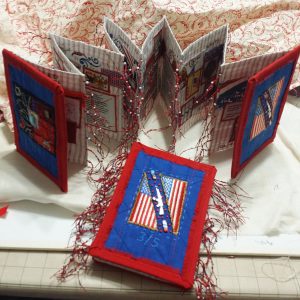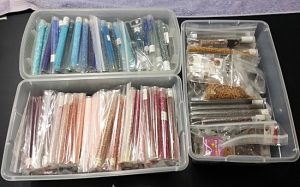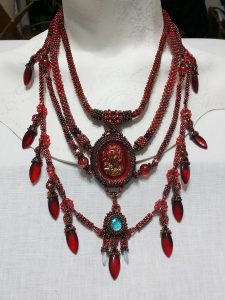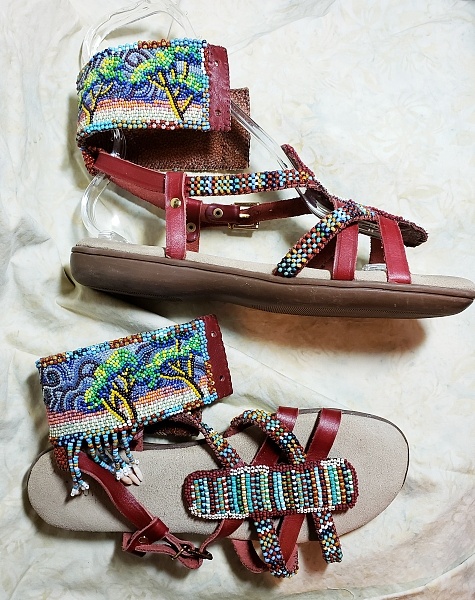Is there any craft more ‘Karen‘ right now, than beadwork?
Bear with me, I’ll circle back to that particular Molotov cocktail.
My little existential crisis is *nothing* to the convulsions my beloved USA is going through right now. And yet, my tiny crisis has a direct link to what we’re seeing right now, in the intersections of cultural appropriation and privilege.
I am a craft artist. I love ‘unserious’ crafts like beadwork, jewelry, and embroidery. That runs deep in my life, going back to probably just after I could walk. I spent years stubbornly avoiding the political in my art, because I believed and still believe that the purely beautiful has an uplifting effect on its makers and viewers.
But damn, the Republican Party…my former party, which I always knew was skanky but hoped it could change from within…went full Jim-Jones-Poison-Cult with its lockstep worship of Donald J. Trump and the Dominionist Christians using him to take over the USA.
So now a lot of my art has to have political and cultural themes or at least sub-currents, or I couldn’t live with myself. Cynically, it doesn’t hurt that museums and universities are willing to pay for my political art, when no one makes a peep about the just-pretty stuff.

I’m going to remind people right now that beadwork is an ancient human craft, a birthright of nearly every culture since we wandered out of Olduvai Gorge.
Aspects, stitches, and patterns do belong to specific cultures, and we out-group crafters ignore that to our moral peril.
My beading craft seems to be the province now of middle-aged white women of at least comfortably middle-class backgrounds, who cheerfully adapt and use other cultures’ beadwork styles. Often selling the results online. While Native, POC, and other marginalized creators can’t eke out a living…or even get through the door unless a gallery falls all over itself to sign them on as a ‘trophy’ artist.
You’d think that glass beads are cheap, but not really. These three shoeboxes of beads, for example, have a current replacement value of around $900.

The financial markup can be remarkable. Last year I had the grim honor of buying up two separate seed bead stashes from estate sales, collected by their former owners for over 40 years. I researched and cataloged every plastic tube of beads. Where I paid $550, the original buyers had spent over $4200…closer to $9500 in today’s adjusted prices.
The mostly-white women doing beadwork in the US generally ignore the hidden costs of their craft, beginning with how and where most beads are made.
Many of our basic beads (seed beads, those tiny 1 to 2mm glass cylinders) come from India and China, as well as larger elaborate lampworked or pressed glass beads. Higher-quality beads come from Japan, Germany, and Eastern Europe. These beads are colored with metals and minerals that are often poisonous to work with. The glass furnaces and shaping machines run on human sweat and vast quantities of energy. People die in this work, or get brain damage and other nervous-system damage.
There’s blood on our beads.
The crafts boom in the USA grew out of the rising middle-class (largely white) incomes in the 60s and 70s, allowing more women to have leisure time to devote to such work. Craft suppliers became more sophisticated, offering more and different outlets and supplies. The vast retirement communities created more time, classes, and socializing options…again, for their largely white Boomer and Greatest Generation residents.
My mother was a Depression-Era sewist good enough to drape fabric and cut patterns on the fly. I covet the skills to recreate some of her Texas square-dance skirts. She dabbled in earthenware ceramics and macrame, those quintessential 70s crafts. Then she discovered needlepoint. She didn’t design her own work, but adapted patterns and kits. I’m still in awe of her skill there, too.
She taught me to sew when I was five-ish.
Even though I lived in the bead-rich, jewelry-rich cultural mix of the Four Corners of the American Southwest, I didn’t really ‘discover’ off-loom beadwork until the early 90s when I read a fabulous Threads Magazine article (and beading tutorial) about American fine-craft artist Joyce Scott.
I learned about nontraditional bead embroidery through another article on the amazing Marcus Amerman, whose polymath approach to craft media never obscures his genius in every single one.
For me, it was like the sunrise. I’d been a silversmith since 1979, and played in embroidery since 1983. Beadwork suddenly became a major obsession.

I’m still obsessed, and so are thousands of my American, European, Asian, and Russian crafters.
The biggest mainstream bead convention is the Bead & Button Show, held in Milwaukee every June (moved this year to August). The cornerstone exhibition is the ‘Bead Dreams’ Contest, where cash prizes are underwritten by major bead and jewelry-making suppliers. I’ve won prizes a few times. I’m trying for an entry again this year, after a hiatus of over a decade. These are the ‘Rain Season Sandals’ in progress.

But the real focus on going to Bead & Button are the classes, teaching complex stitches and techniques to people able to pay for travel, a week’s hotel stay, food, contest entry fees, and seminar costs. Beadwork experts look on teaching gigs as a career move that enables them to reach more crafters with ongoing classes and lucrative kits. Big-name craft museums court the best of these artists. Celebrities covet and wear their art.
Most of these artists are white women. There will be a few POC and Native presenters or attendees, more in the last few years. But like a writing career, a career in fine-craft can be a game for the privileged.
Or the Russians. Russian beadworkers are amazing and they’ve beaten the system. They’ve taken the simplest of craft supplies — beads and thread — and turned them into gorgeous wearable art and craft objects. I’m not going to link to a specific Russian artist. Google-Fu and Pinterest can show you the masters of their craft.
But I will bring attention to a few observations.
First, Russian beadworkers, like many Russian artists, have access to some government assistance as far as material and career development. Russian history is filled with glorious crafts held in national esteem. Each accolade is a validation of Russian pride.
Second, you will rarely spot anything overtly political in Russian exhibition-level beadwork. It’s gorgeous, it’s meant to be gorgeous, and if there’s anything deeper in it, the meaning and intent will be very subtle. Political gets discouraged, or punished.
Third, these Russian bead geniuses are mostly white women (a few non-white indigenous folks from are in the mix, but not many.) That oddly befits Russia’s tendency toward homogeneity and its political posturing as a new Christian White Homeland.
I’m not callow enough to tint every hard-working Russian beadwork artist as a state-sanctioned cultural operative. They love the pure work as much as I do.
I’m also not naive about the hordes of (often white, often conservative) American women jewelry artists making money on Etsy crafts. There’s a disquieting intersection in much of their social media, with Trump-supporting white-nationalist movements. They’re sometimes disparagingly called ‘mommy crafters’ because they often work out of home businesses and run conservative-extolling social media sites.
Many of them are Art-Karens, bristling with instant fury whenever anyone calls them out on derivative and/or stolen designs.
Every time I visited a bead store pre-Covid19 and watched white women of privilege steamroll over other shoppers, I winced. When I looked at the bios and headshots of white women in fine-crafts shows and magazines, I wondered how many artists of color, how many Natives, were shut out for not knowing how to play the promotional game.
How many will never know, because beadwork is to them a distant art, maybe seen as a costume piece in a big-budget movie or TV show?
Humans are a creative bunch. I’d like to see us all be more creative, and less violent.
As our cities burn in ways we haven’t seen since 1992 or 1968, I wonder how that is possible.